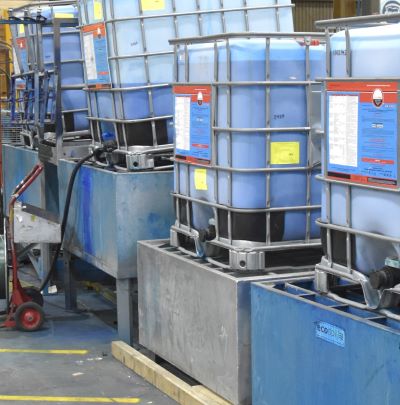Treatment chemicals

Different preservatives are used to treat timber to different hazard levels (as described in the previous lesson: Hazard classes).
The chemicals are usually mixed with a liquid ‘carrier agent’ such as water, solvents or oils. This helps to carry the solution into the cell cavities of the wood tissue (discussed in the next lesson: Treatment methods).
Below are the main types of chemicals used in preservative treated timber, grouped according to the liquid carrier they’re dissolved in.
Water-borne preservatives
CCA – Copper, Chrome, Arsenic – is the most widely used treatment for hazard levels H3 to H6. In recent years, however, it has been banned from use in applications that involve close human contact due to the arsenic content. The arsenic resists insect attack, the copper and arsenic together protect against fungal decay, and the chromium helps to lock the chemicals in place so they don’t leach out of the timber over time.
ACQ – Alkaline (or Ammoniacal) Copper Quarternary – provides protection up to hazard level H4, and is extensively used to treat landscaping timbers. The timber is generally dearer than equivalent CCA-treated products, but it is arsenic-free. The copper is a fungicide and the quarternary ammonium compounds work as a fungicide and insecticide.
CA (or CuAz) – Copper Azole – is another arsenic-free alternative to CCA, with protection up to hazard level H4. It contains copper, boric acid and tebuconazole, and is sometimes marketed under the brand name TanE, or TanalithE.
Although the above preservatives are all water-based, they react chemically with the wood during the treatment process and become insoluble in the finished product. This is an important characteristic for any treated timber that will be exposed to water or other agents that might try to leach the chemicals out of the wood fibres.
Boron is also a water-based preservative, but unlike the other three types of preservatives, it doesn’t become insoluble after treatment. This means that the treated timber needs to be kept dry to avoid the problem of leaching. Boron is typically used for treating internal timbers (such as in flooring, mouldings and framing) against lyctid borer attack.
Oil-borne preservatives
Creosote has been used as a timber preservative for over a century. It is derived from coal or wood and has a dark tar colour. It’s now known to cause serious health problems, including cancer, so these days its use is generally restricted to treating power poles, railway sleepers, bridge components and marine piles (in conjunction with CCA).
PEC – Pigment Emulsified Creosote – is a derivative of high temperature creosote (HTC), with water and pigments added to resist leaching and reduce the very strong odour that creosote has. Again, it is generally only used in outdoor industrial situations.
Solvent-borne preservatives
LOSP – Light Organic Solvent Preservatives – use a light organic solvent as the carrier agent. They are only suitable for treating timber to H2 or H3 hazard levels and are commonly used on joinery and framing products.
Chemical formulations include:
Copper naphthenate (CuN) – a fungicide with a distinctive green colour
Tributyl tin (TBT) preservatives – including tributyl tin naphthenate (TBTN) and tributyl tin oxide (TBTO) – fungicides that are often used in conjunction with insecticides and waxes
Synthetic pyrethroids – insecticides, similar to those used in fly sprays and flea collars, applied as an envelope treatment against termites, particularly in H2F ‘blue pine’.